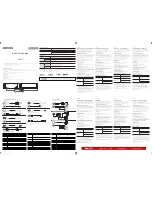
The Fitzpatrick Company
D6B Manual Ver 1_24 Jan 2012-DRAFT.doc
A Unit of
Corporation
Page 20 of 49
SECTION 3:
Machine Set Up
3.1 Operating
Speeds
Motors are typically supplied with base speeds of 1800 or 3600 rpm for 60 hertz duty (1500
or 3000 rpm for 50 hertz). Actual slip speed, as stamped on the motor nameplate, will be
slightly less than these nominal ratings (e.g. 1750rpm, 3525 rpm, etc…). The Fitzpatrick
Company has designed your machine to meet the rotor operating speed(s) as defined in
your order documents and confirmed on the
Comminutor Specification Sheet
.
The typical operating range for the D6B Comminutor is:
1,000 – 4,600 RPM
when using the conventional rotor
100 – 1,000 RPM
maximum when using a bar rotor for gentle particle size reduction
With most model D6B machines, the mill rotor is directly coupled to the drive motor.
Therefore, motor speed = rotor speed. The D6B can also be supplied with a belt driven for
higher speed range when explosion proof or Atex motors are required. Normally these
motors are not allowed to exceed 1.5 times base motor speed. Most D6B machines are
equipped for operation over a working speed range (min-to-max) which is stated on your
Comminutor Specification Sheet
. Motor speed is controlled by use of a variable
frequency drive (VFD). Depending upon the configuration of your specific D6B, speed
control through the VFD may be accomplished by one of three control devices:
1. A manually operated speed control potentiometer, located on the base of the
machine (older machines).
2. An electronic Human Interface Module (HIM) with digital readout.
3. Controlled by a PLC with touch screen. This option normally used for D6B
machines with advanced features such as Product Containment systems,
Nitrogen Inerting / Oxygen Sensing or where the D6B is integrated as part of a
Chilsonator granulating system.
See section 4 of this manual for additional information regarding machine controls.








































